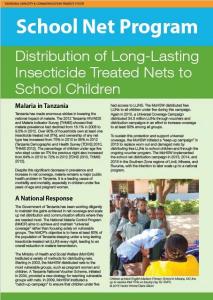Tanzania School Net Program
This brief describes the Tanzania School Net Program which involved distribution of treated nets to both children ages 6-14 years and heads of household as primary audiences, empowering these audiences to take action while clearly conveying the benefits of getting everyone covered – including neighbors – by drawing on popular “sharing” beliefs that exist in Tanzania. The school net program (SNP) also targeted primary school teachers, TCCP Community Change Agents, Ward Educational Coordinators, and other stakeholders, including local government authority (LGA) officials, heads of schools, ward and village officials.
The effort included community outreach, radio spots, district-wide events, and school activities.
Through the Patapata radio program, children were inspired to talk to their parents, friends, and communities about malaria prevention behaviors such as sleeping under a net every night, proper net use, net care and repair, and net sharing. Anecdotal feedback from Community Change Agents indicated that children enjoyed the program, and that parents reported increased interpersonal communication with their children about the importance of sleeping under the nets they were given at school.
Source: Johns Hopkins University Center for Communication Programs
Date of Publication: March 25, 2019
SIMILIAR RESOURCES
Tools
Examples
- SBCC for Malaria in Pregnancy: Strategy Development Guidance
- Zika Virus Global Emergency Response Plan
- Promoting Quality Malaria Medicines Through SBCC: An Implementation Kit
- Social Franchising: Improving Quality and Expanding Contraceptive Choice in the Private Sector
- Intersectionality 101
- Gender Integration in Social and Behavior Change: What Does it Take
- What Does it Mean to Leave No One Behind? A United Nations Development Programme Discussion Paper and Framework for Implementation
- 10 Best Resources on Intersectionality with an Emphasis on Low- and Middle-Income Countries
- Desk Review of Programs Integrating Family Planning with Food Security and Nutrition
- PAHO Strategic and Operational Plan for Responding to Pandemic Influenza

